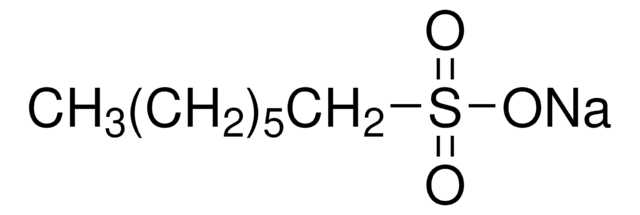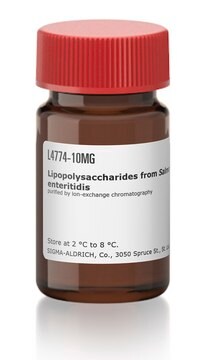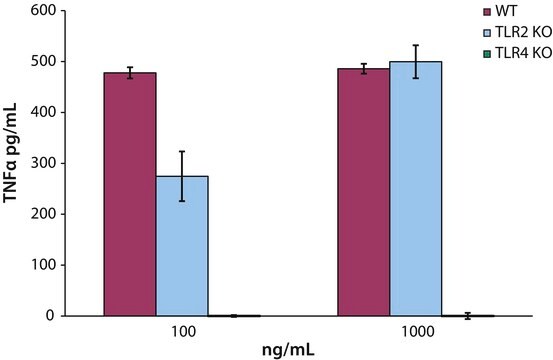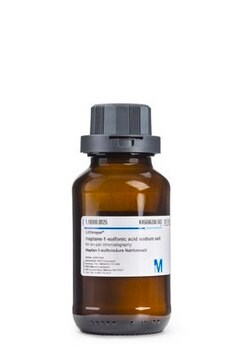L9764
Lipopolysaccharides (rough strains) from Salmonella enterica serotype minnesota Re 595 (Re mutant)
Sinonimo/i:
LPS
Autenticatiper visualizzare i prezzi riservati alla tua organizzazione & contrattuali
About This Item
Prodotti consigliati
Origine biologica
Salmonella enterica (Serotype minnesota Re 595 mutant)
Livello qualitativo
Stato
lyophilized powder
Impurezze
<3% Protein (Lowry)
Colore
white to yellow cast
Solubilità
water: 0.90-1.10 mg/mL, hazy to turbid, colorless to faintly yellow
Condizioni di spedizione
ambient
Temperatura di conservazione
2-8°C
Cerchi prodotti simili? Visita Guida al confronto tra prodotti
Categorie correlate
Descrizione generale
This product is prepared from Salmonella Minnesota strain Re 595 (Re mutant) using a phenol-chloroform-petroleum ether extraction procedure. The source strain is ATCC 49284. A unique structure in the LPS of strain Re 595 was shown to induce secretion and aggregation in human platelets.
Applicazioni
- Charge and aggregation pattern govern the interaction of plasticins with LPS monolayers mimicking the external leaflet of the outer membrane of Gram-negative bacteria: This study examines how charge and aggregation patterns affect the interaction of plasticins with lipopolysaccharides (LPS) from rough strains like Salmonella enterica serotype Minnesota Re 595. The findings contribute to understanding the molecular interactions involved in microbial resistance mechanisms (Michel et al., 2015).
Azioni biochim/fisiol
Lipopolysaccharides (LPS) are localized in the outer layer of the membrane and are, in noncapsulated strains, exposed on the cell surface. They contribute to the integrity of the outer membrane, and protect the cell against the action of bile salts and lipophilic antibiotics.
Nota sulla preparazione
Prepared by phenol-chloroform-petroleum ether extraction.
The product is soluble in water (5 mg/ml) or cell culture medium (1 mg/ml) yielding a hazy, faint yellow solution. A more concentrated, though still hazy, solution (20 mg/ml) has been achieved in aqueous saline after vortexing and warming to 70-80 oC. Lipopolysaccharides are molecules that form micelles in every solvent. Hazy solutions are observed in water and phosphate buffered saline. Organic solvents do not give clearer solutions. Methanol yields a turbid suspension with floaters, while water yields a homogeneously hazy solution.
The product is soluble in water (5 mg/ml) or cell culture medium (1 mg/ml) yielding a hazy, faint yellow solution. A more concentrated, though still hazy, solution (20 mg/ml) has been achieved in aqueous saline after vortexing and warming to 70-80 oC. Lipopolysaccharides are molecules that form micelles in every solvent. Hazy solutions are observed in water and phosphate buffered saline. Organic solvents do not give clearer solutions. Methanol yields a turbid suspension with floaters, while water yields a homogeneously hazy solution.
Altre note
To gain a comprehensive understanding of our extensive range of Lipopolysaccharides for your research, we encourage you to visit our Carbohydrates Category page.
Prodotti correlati
N° Catalogo
Descrizione
Determinazione del prezzo
Avvertenze
Warning
Indicazioni di pericolo
Consigli di prudenza
Classi di pericolo
Acute Tox. 4 Oral
Codice della classe di stoccaggio
11 - Combustible Solids
Classe di pericolosità dell'acqua (WGK)
WGK 3
Punto d’infiammabilità (°F)
Not applicable
Punto d’infiammabilità (°C)
Not applicable
Dispositivi di protezione individuale
dust mask type N95 (US), Eyeshields, Gloves
Scegli una delle versioni più recenti:
Possiedi già questo prodotto?
I documenti relativi ai prodotti acquistati recentemente sono disponibili nell’Archivio dei documenti.
I clienti hanno visto anche
S Kumar et al.
Parasite immunology, 34(7), 372-382 (2012-04-11)
Studies have shown that glycosylphosphatidylinositols (GPIs) of Plasmodium falciparum activate macrophages mainly through Toll-like receptor 2 (TLR2)-mediated signalling and to certain extent through TLR4-mediated signalling to induce proinflammatory cytokine production. However, the ability of parasite GPIs to activate dendritic cells
Ahsan F Malik et al.
Proceedings of the National Academy of Sciences of the United States of America, 108(50), 20095-20100 (2011-11-24)
Implantation of biomaterials and devices into soft tissues leads to the development of the foreign body response (FBR), which can interfere with implant function and eventually lead to failure. The FBR consists of overlapping acute and persistent inflammatory phases coupled
Emmanuelle Kuhn et al.
American journal of physiology. Endocrinology and metabolism, 306(1), E75-E90 (2013-11-14)
The mineralocorticoid receptor (MR) exerts proadipogenic and antithermogenic effects in vitro, yet its in vivo metabolic impact remains elusive. Wild type (WT) and transgenic (Tg) mice overexpressing human MR were subjected to standard chow (SC) or high-fat diet (HFD) for
Xianzhu Wu et al.
Journal of immunology (Baltimore, Md. : 1950), 184(8), 4338-4348 (2010-03-17)
Dendritic cells (DCs) play a crucial role in the development of protective immunity to malaria. However, it remains unclear how malaria parasites trigger immune responses in DCs. In this study, we purified merozoites, food vacuoles, and parasite membrane fragments released
Anna E Karagianni et al.
Veterinary immunology and immunopathology, 155(4), 219-228 (2013-08-28)
Alveolar macrophages (AMs) constitute the first line of defence in the lung of all species, playing a crucial role in the regulation of immune responses to inhaled pathogens. A detailed understanding of the function and phenotype of AMs is a
Il team dei nostri ricercatori vanta grande esperienza in tutte le aree della ricerca quali Life Science, scienza dei materiali, sintesi chimica, cromatografia, discipline analitiche, ecc..
Contatta l'Assistenza Tecnica.







